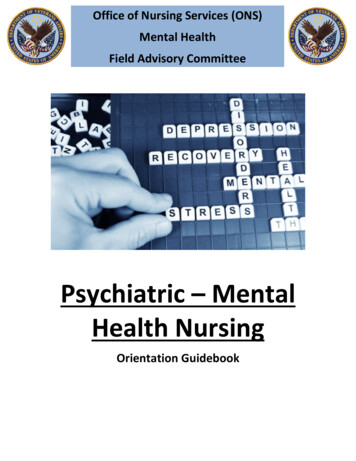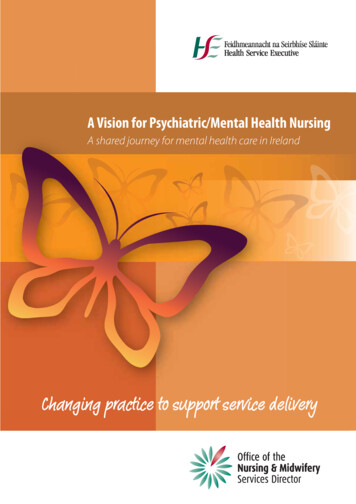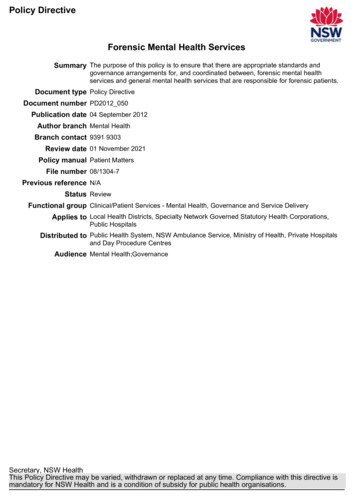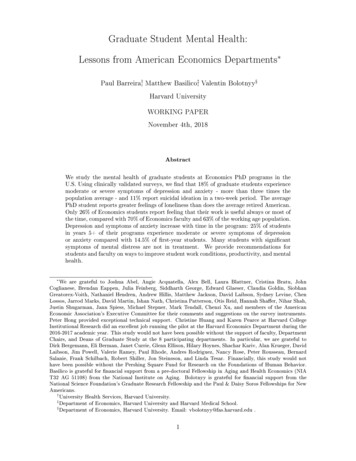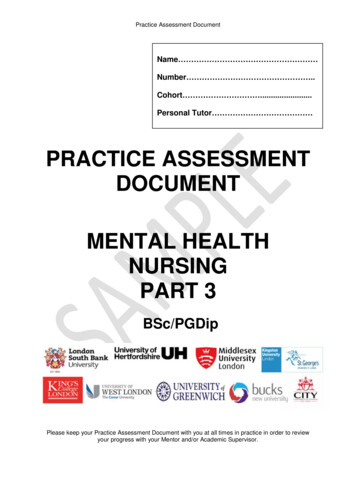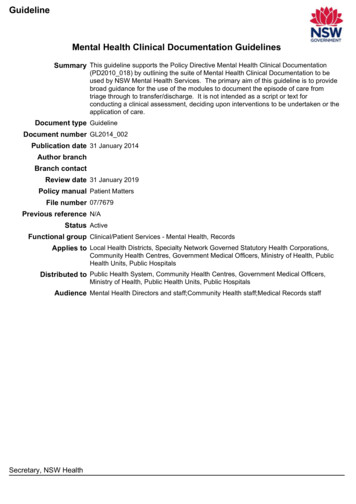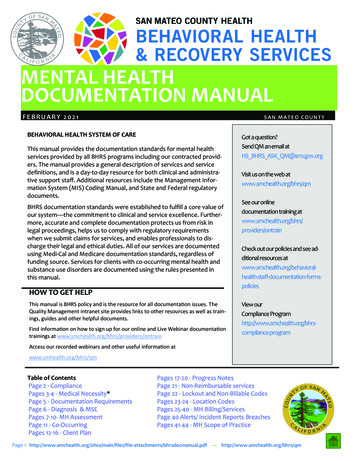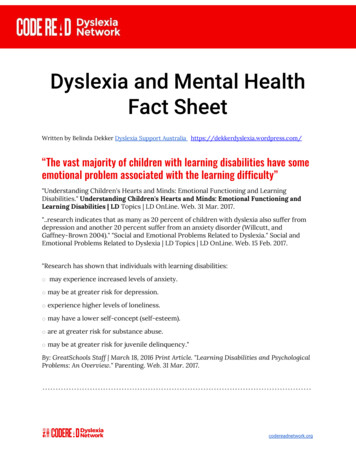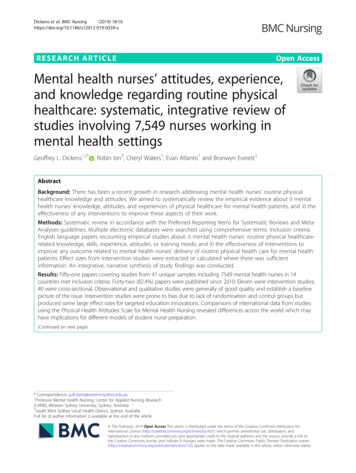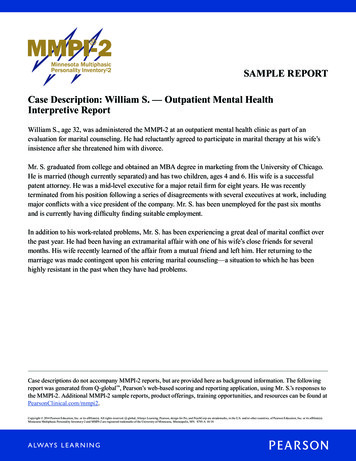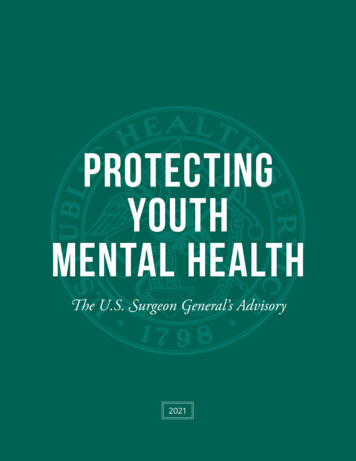
Transcription
ProtectingYouthMental HealthThe U.S. Surgeon General’s Advisory2021Protecting Youth Mental Health: The U.S. Surgeon General’s Advisory1
Table of ContentsINTRODUCTION FROM THE SURGEON GENERAL3ABOUT THE ADVISORY5BACKGROUND6WE CAN TAKE ACTION12What Young People Can Do14What Family Members and Caregivers Can Do16What Educators, School Staff, and School Districts Can Do19What Health Care Organizations and Health Professionals Can Do21What Media Organizations, Entertainment Companies, and Journalists Can Do23What Social Media, Video Gaming, and Other Technology Companies Can Do25What Community Organizations Can Do29What Funders and Foundations Can Do31What Employers Can Do33What Federal, State, Local, and Tribal Governments Can Do35Where Additional Research is rotecting Youth Mental Health: The U.S. Surgeon General’s Advisory2
Introduction fromthe Surgeon GeneralEvery child’s path to adulthood—reaching developmental andemotional milestones, learning healthy social skills, and dealing withproblems—is different and difficult. Many face added challengesalong the way, often beyond their control. There’s no map, and theroad is never straight.But the challenges today’s generation of young people face areunprecedented and uniquely hard to navigate. And the effect thesechallenges have had on their mental health is devastating.Recent national surveys of young people have shown alarmingincreases in the prevalence of certain mental health challenges—in 2019, one in three high school students and half of femalestudents reported persistent feelings of sadness or hopelessness, anoverall increase of 40% from 2009. We know that mental health isshaped by many factors, from our genes and brain chemistry to ourrelationships with family and friends, neighborhood conditions, andlarger social forces and policies. We also know that, too often, youngpeople are bombarded with messages through the media and popularculture that erode their sense of self-worth—telling them they arenot good looking enough, popular enough, smart enough, or richenough. That comes as progress on legitimate, and distressing, issueslike climate change, income inequality, racial injustice, the opioidepidemic, and gun violence feels too slow.And while technology platforms have improved our lives inimportant ways, increasing our ability to build new communities,deliver resources, and access information, we know that, for manypeople, they can also have adverse effects. When not deployedresponsibly and safely, these tools can pit us against each other,reinforce negative behaviors like bullying and exclusion, andundermine the safe and supportive environments young people needand deserve.Protecting Youth Mental Health: The U.S. Surgeon General’s Advisory3
All of that was true even before the COVID-19 pandemicdramatically altered young peoples’ experiences at home, at school,and in the community. The pandemic era’s unfathomable numberof deaths, pervasive sense of fear, economic instability, and forcedphysical distancing from loved ones, friends, and communities haveexacerbated the unprecedented stresses young people already faced.It would be a tragedy if we beat back one public health crisis onlyto allow another to grow in its place. That’s why I am issuing thisSurgeon General’s Advisory. Mental health challenges in children,adolescents, and young adults are real, and they are widespread. Butmost importantly, they are treatable, and often preventable. ThisAdvisory shows us how.To be sure, this isn’t an issue we can fix overnight or with a singleprescription. Ensuring healthy children and families will take an all-ofsociety effort, including policy, institutional, and individual changesin how we view and prioritize mental health. This Advisory providesactionable recommendations for young people and their families,schools and health care systems, technology and media companies,employers, community organizations, and governments alike.Our obligation to act is not just medical—it’s moral. I believe that,coming out of the COVID-19 pandemic, we have an unprecedentedopportunity as a country to rebuild in a way that refocuses ouridentity and common values, puts people first, and strengthens ourconnections to each other.If we seize this moment, step up for our children and their familiesin their moment of need, and lead with inclusion, kindness, andrespect, we can lay the foundation for a healthier, more resilient, andmore fulfilled nation.Vivek H. Murthy, M.D., M.B.A.Vice Admiral, U.S. Public Health ServiceSurgeon General of the United StatesProtecting Youth Mental Health: The U.S. Surgeon General’s Advisory4
ABOUT THE ADVISORYA Surgeon General’s Advisory is a public statement that calls the American people’s attention to an urgentpublic health issue and provides recommendations for how it should be addressed. Advisories are reservedfor significant public health challenges that need the nation’s immediate awareness and action.This Advisory offers recommendations for supporting the mental health of children, adolescents, andyoung adults. While many of these recommendations apply to individuals, the reality is that people havewidely varying degrees of control over their circumstances. As a result, not all recommendations will befeasible for everyone.That’s why systemic change is essential. The Advisory includes essential recommendations for theinstitutions that surround young people and shape their day-to-day lives—schools, communityorganizations, health care systems, technology companies, media, funders and foundations, employers, andgovernment. They all have an important role to play in supporting the mental health of children and youth.For additional background and to read other Surgeon General’s Advisories, visit SurgeonGeneral.gov.Protecting Youth Mental Health: The U.S. Surgeon General’s Advisory5
BACKGROUNDYouth Mental Health Prior to theCOVID-19 PandemicMental health affects every aspect of our lives: how we feel about ourselves and the world; solve problems,cope with stress, and overcome challenges; build relationships and connect with others; and perform inschool, at work, and throughout life. Mental health encompasses our emotional, psychological, and socialwellbeing, and is an essential component of overall health.1 As described in the 1999 Surgeon General’sReport on Mental Health, it is the “springboard of thinking and communication skills, learning,emotional growth, resilience and self-esteem.”2Mental health challenges can be difficult to define, diagnose, and address, partly because it isn’t alwaysclear when an issue is serious enough to warrant intervention.2 All of us, at all ages, occasionallyexperience fear, worry, sadness, or distress. In most cases, these symptoms are short-lived and don’t affectour ability to function. But, at other times, symptoms can cause serious difficulties with daily functioningand affect our relationships with others, as in the case of conditions such as anxiety disorders, majordepressive disorder, schizophrenia, bipolar disorder, and eating disorders, among others.3Mental health conditions can be shaped by biological factors, including genes and brain chemistry,and environmental factors, including life experiences. Some mental health disorders seem to cluster infamilies, but they are often shaped by multiple genes, and whether an individual develops symptoms canbe further modified by their experiences and surrounding environment.4, 5 Environmental factors canrange from exposure to alcohol or drugs during pregnancy, to birth complications, to discrimination andracism, to adverse childhood experiences (ACEs) such as abuse, neglect, exposure to community violence,and living in under-resourced or racially segregated neighborhoods.6, 7, 8, 9, 10, 11, 12 ACEs can undermine achild’s sense of safety, stability, bonding, and wellbeing.13 Moreover, ACEs may lead to the developmentof toxic stress. Toxic stress can cause long lasting changes, including disrupting brain development andincreasing the risk for mental health conditions and other health problems such as obesity, heart disease,and diabetes, both during and beyond childhood as well as for future generations.12, 14Biological and environmental factors can also be interrelated, making it difficult to isolate unique “causes”of mental health challenges. For example, if a child is genetically predisposed to depression, they mightbe more affected by experiences such as bullying than other children.15, 16Figure 1 (next page) includes a longer list of factors that shape the mental health of young people.Protecting Youth Mental Health: The U.S. Surgeon General’s Advisory6
FIGURE 1Protecting Youth Mental Health: The U.S. Surgeon General’s Advisory7
Even before the COVID-19 pandemic, mental health challenges were the leading cause of disability andpoor life outcomes in young people, with up to 1 in 5 children ages 3 to 17 in the US with a reportedmental, emotional, developmental, or behavioral disorder.17 In 2016, of the 7.7 million children withtreatable mental health disorder, about half did not receive adequate treatment.18Unfortunately, in recent years, national surveys of youth have shown major increases in certain mentalhealth symptoms, including depressive symptoms and suicidal ideation. From 2009 to 2019, theproportion of high school students reporting persistent feelings of sadness or hopelessness increasedby 40%; the share seriously considering attempting suicide increased by 36%; and the share creatinga suicide plan increased by 44%.19 Between 2011 and 2015, youth psychiatric visits to emergencydepartments for depression, anxiety, and behavioral challenges increased by 28%.20 Between 2007 and2018, suicide rates among youth ages 10-24 in the US increased by 57%.21 Early estimates from theNational Center for Health Statistics suggest there were tragically more than 6,600 deaths by suicideamong the 10-24 age group in 2020.22Scientists have proposed various hypotheses to explain these trends. While some believe that the trendsin reporting of mental health challenges are partly due to young people becoming more willing to openlydiscuss mental health concerns,23 other researchers point to the growing use of digital media,24, 25, 26increasing academic pressure,27, 28, 29 limited access to mental health care,18, 30 health risk behaviors such asalcohol and drug use,31 and broader stressors such as the 2008 financial crisis, rising income inequality,racism, gun violence, and climate change.32, 33, 34, 35It’s also important to acknowledge that the prevalence of mental health challenges varies acrosssubpopulations. For instance, girls are much more likely to be diagnosed with anxiety, depression, or aneating disorder, while boys are more likely to die by suicide or be diagnosed with a behavior disorder,such as attention deficit hyperactivity disorder (ADHD).36, 37, 38 In recent years, suicide rates among Blackchildren (below age 13) have been increasing rapidly, with Black children nearly twice as likely to die bysuicide than White children.39 Moreover, socioeconomically disadvantaged children and adolescents—for instance, those growing up in poverty—are two to three times more likely to develop mental healthconditions than peers with higher socioeconomic status.40Protecting Youth Mental Health: The U.S. Surgeon General’s Advisory8
The COVID-19 Pandemic’s Impact on theMental Health of Children and YouthDuring the pandemic, children, adolescents, and young adults have faced unprecedented challenges. TheCOVID-19 pandemic has dramatically changed their world, including how they attend school, interactwith friends, and receive health care. They missed first days of school, months or even years of in-personschooling, graduation ceremonies, sports competitions, playdates, and time with relatives. They andtheir family may have lost access to mental health care, social services, income, food, or housing.41 Theymay have had COVID-19 themselves, suffered from long COVID symptoms, or lost a loved one to thedisease—it’s estimated that as of June 2021, more than 140,000 children in the US had lost a parent orgrandparent caregiver to COVID-19.42Since the pandemic began, rates of psychological distress among young people, including symptomsof anxiety, depression, and other mental health disorders, have increased. Recent research covering80,000 youth globally found that depressive and anxiety symptoms doubled during the pandemic, with25% of youth experiencing depressive symptoms and 20% experiencing anxiety symptoms.43 Negativeemotions or behaviors such as impulsivity and irritability—associated with conditions such as ADHD—appear to have moderately increased.44 Early clinical data are also concerning: In early 2021, emergencydepartment visits in the United States for suspected suicide attempts were 51% higher for adolescentgirls and 4% higher for adolescent boys compared to the same time period in early 2019.45 Moreover,pandemic-related measures reduced in-person interactions among children, friends, social supports, andprofessionals such as teachers, school counselors, pediatricians, and child welfare workers. This made itharder to recognize signs of child abuse, mental health concerns, and other challenges.46During the pandemic, young people also experienced other challenges that may have affected theirmental and emotional wellbeing: the national reckoning over the deaths of Black Americans at thehands of police officers, including the murder of George Floyd; COVID-related violence against AsianAmericans; gun violence; an increasingly polarized political dialogue; growing concerns about climatechange; and emotionally-charged misinformation.47, 48, 49, 50, 51Although the pandemic’s long-term impact on children and young people is not fully understood, thereis some cause for optimism. According to more than 50 years of research, increases in distress symptomsare common during disasters, but most people cope well and do not go on to develop mental healthdisorders.52 Several measures of distress that increased early in the pandemic appear to have returned topre-pandemic levels by mid-2020.53, 54 Some other measures of wellbeing, such as rates of life satisfactionand loneliness, remained largely unchanged throughout the first year of the pandemic.53, 55 And whiledata on youth suicide rates are limited, early evidence does not show significant increases.56, 57In addition, some young people thrived during the pandemic: They got more sleep, spent more qualitytime with family, experienced less academic stress and bullying, had more flexible schedules, andimproved their coping skills.44, 58, 59, 60 Many young people are resilient, able to bounce back from difficultexperiences such as stress, adversity, and trauma.61Protecting Youth Mental Health: The U.S. Surgeon General’s Advisory9
That said, the pandemic is ongoing, with nearly 1,000 Americans dying per day as of early December2021.62 And many millions of children and youth have faced and continue to face major challenges.Importantly, the pandemic’s negative impacts, such as illness and death in families and disruptions inschool and social life, disproportionately impacted those who were vulnerable to begin with and wideneddisparities.63 For additional details, see Boxes 1 and 2. Box 1 discusses risk factors contributing tochildren’s mental health symptoms during the pandemic. Box 2 discusses demographic groups at greaterrisk of developing mental health problems during the pandemic.BOX 1Risk factors contributing to Youth mental health symptomsDuring the pandemic Note: Not a comprehensive list of risk factorsHaving mental health challenges before the pandemic61, 64Living in an urban area or an area with more severe COVID-19 outbreaks65Having parents or caregivers who were frontline workers66Having parents or caregivers at elevated risk of burnout (for example, due to parenting demands)67, 68Being worried about COVID-1964Experiencing disruptions in routine, such as not seeing friends or going to school in person69, 70, 71Experiencing more adverse childhood experiences (ACEs) such as abuse, neglect, communityviolence, and discrimination72, 73, 74Experiencing more financial instability, food shortages, or housing instability75, 76Experiencing trauma, such as losing a family member or caregiver to COVID-1977Protecting Youth Mental Health: The U.S. Surgeon General’s Advisory10
BOX 2Groups at higher risk of mental health challenges during the pandemicNote: Not a comprehensive list of groups or risk factorsYouth with intellectual and developmental disabilities (IDDs), who found it especially difficult tomanage disruptions to school and services such as special education, counseling, occupational, andspeech therapies78, 79, 80, 81, 82Racial and ethnic minority youth,83 including:American Indian and Alaska Native youth, many of whom faced challenges staying connectedwith friends and attending school due to limited internet access84Black youth, who were more likely than other youth to lose a parent or caregiver to COVID-1942Latino youth, who reported high rates of loneliness and poor or decreased mental health duringthe pandemic85, 86Asian American, Native Hawaiian, and Pacific Islander youth, who reported increased stressdue to COVID-19-related hate and harassment87, 88LGBTQ youth, who lost access to school-based services and were sometimes confined to homeswhere they were not supported or accepted89, 90Low-income youth, who faced economic, educational, and social disruptions (for example, losingaccess to free school lunches)91Youth in rural areas, who faced additional challenges in participating in school or accessing mentalhealth services (for example, due to limited internet connectivity)92Youth in immigrant households, who faced language and technology barriers to accessing healthcare services and education93Special youth populations, including youth involved with the juvenile justice, or child welfaresystems, as well as runaway youth and youth experiencing homelessness61, 94, 95, 96Additional considerations:Youth with multiple risk factors. Many young people are part of more than one at-risk group,which can put at them at even higher risk of mental health challenges. For example, children withIDDs who lost a parent to COVID-19, or Black children from low-income families, may requireadditional support to address multiple risk factors.97Discrimination in the health care system. Some groups of youth and their families, such aspeople of color, immigrants, LGBTQ people, and people with disabilities, may be more hesitantto engage with the health care system (including mental health services) due to current and pastexperiences with discrimination.97, 98, 99Risks of COVID-19 to children with mental health conditions. Children with mooddisorders, such as depression and bipolar disorder, as well as schizophrenia spectrum disorders, areat elevated risk of severe COVID-19 illness.100, 101, 102Protecting Youth Mental Health: The U.S. Surgeon General’s Advisory11
WE CAN TAKE ACTIONThe good news is that, throughout the pandemic, many people have recognized the unprecedentedneed to support youth mental health and wellbeing and have taken action to do so. Many young peoplefound ways to cope with disruption and stay connected.103 Families helped children adjust to remotelearning.104 Educators and school staff supported their students while facing unprecedented challengesthemselves.105 Health care professionals rapidly shifted to telehealth.106 Community organizations steppedin to protect at-risk youth.107 Employers helped employees adapt to remote work environments.108 Andgovernments invested trillions of dollars to mitigate financial hardship for families, support COVID-19testing and vaccination, provide health care and other social services, and support the safe reopening ofschools, among other policies.109, 110, 111But there is much more to be done, and each of us has a role to play. Supporting the mental healthof children and youth will require a whole-of-society effort to address longstanding challenges,strengthen the resilience of young people, support their families and communities, and mitigate thepandemic’s mental health impacts. Here is what we must do:Recognize that mental health is an essential part of overall health. Mental health conditions arereal, common, and treatable, and people experiencing mental health challenges deserve support,compassion, and care, not stigma and shame. Mental health is no less important than physical health.And that must be reflected in our how we communicate about and prioritize mental health.Empower youth and their families to recognize, manage, and learn from difficult emotions.For youth, this includes building strong relationships with peers and supportive adults, practicingtechniques to manage emotions, taking care of body and mind, being attentive to use of social mediaand technology, and seeking help when needed. For families and caregivers, this means addressingtheir own mental health and substance use conditions, being positive role models for children,promoting positive relationships between children and others as well as with social media andtechnology, and learning to identify and address challenges early. Youth and families should knowthat asking for help is a sign of strength.Ensure that every child has access to high-quality, affordable, and culturally competent mentalhealth care. Care should be tailored to children’s developmental stages and health needs, andavailable in primary care practices, schools, and other community-based settings. It’s particularlyimportant to intervene early, so that emerging symptoms don’t turn into crises.Protecting Youth Mental Health: The U.S. Surgeon General’s Advisory12
Support the mental health of children and youth in educational, community, and childcaresettings. This includes creating positive, safe, and affirming educational environments, expandingprogramming that promotes healthy development (such as social and emotional learning), andproviding a continuum of supports to meet the social, emotional, behavioral, and mental healthneeds of children and youth. To achieve this, we must also expand and support the early childhoodand education workforce.Address the economic and social barriers that contribute to poor mental health for youngpeople, families, and caregivers. Priorities should include reducing child poverty and ensuringaccess to quality childcare, early childhood services, and education; healthy food; affordable healthcare; stable housing; and safe neighborhoods.112, 113Increase timely data collection and research to identify and respond to youth mental healthneeds more rapidly. The country needs an integrated, real-time data infrastructure for understandingyouth mental health trends. More research is also needed on the relationship between technologyand mental health, and technology companies should be more transparent with their data andalgorithmic processes to enable this research. We also need to better understand the needs of at-riskyouth, including youth facing multiple risk factors. Governments and other stakeholders shouldengage directly with young people to understand trends and design effective solutions.Protecting Youth Mental Health: The U.S. Surgeon General’s Advisory13
WE CAN TAKE ACTIONWhat Young People Can DoSince many of the challenges young people face are outside of their control, we need a whole-of-societyeffort to support children’s mental health and wellbeing from birth to adulthood. That said, below areimportant steps children and young people themselves can take to protect, improve, and advocate fortheir mental health and that of their family, friends, and neighbors:Remember that mental health challenges are real, common, and treatable. Struggling with yourmental health does not mean you are broken or that you did something wrong. Mental health isshaped by many factors, including biology and life experiences, and there are many ways mentalhealth challenges can be addressed.Ask for help. Find trusted adults, friends, or family members to talk to about stressful situations. Forexample, if you or someone you know is being bullied, tell a trusted adult. If you are struggling tomanage negative emotions, reach out to a school nurse or counselor, a teacher, a parent or caregiver,a coach, a faith leader, or someone else you look up to and trust. Look into therapy or counselingresources to get support when something causes distress and interferes with your life. Reaching out toothers can be hard and takes courage, but it is worth the effort and reminds us we are not alone.Invest in healthy relationships. Social connection is a powerful buffer to stress and a source ofwellbeing. But too often in our fast-paced lives, quality time with people gets crowded out. Makespace in your life for the people you love. Spend time with others regularly, in-person and virtually.114Find people who support and care about you and have open and honest conversations with themabout your feelings. Get involved in group activities, such as recreation and outdoor activities, afterschool programs, and mentorship programs.115Find ways to serve. Volunteering in your community and helping others can be a great way toconnect with people, build a sense of purpose, and develop your own sense of self-worth.116 Helpingothers when you are the one struggling can seem counterintuitive. But service is a powerful antidoteto isolation, and it reminds us that we have value to add to the world.Learn and practice techniques to manage stress and other difficult emotions. Try to recognizesituations that may be emotionally challenging for you, and come up with strategies to manage thoseemotions. For example, if you find it stressful to look at COVID-related news, try to check the newsless often, take a break for a day or a week at a time, keep notifications off throughout the day, andavoid looking at negative stories before bed.51Protecting Youth Mental Health: The U.S. Surgeon General’s Advisory14
Take care of your body and mind. Stick to a schedule, eat well, stay physically active, get qualitysleep, stay hydrated, and spend time outside.117, 118, 119 And avoid substances that can ultimately makeyou feel tired, down, or depressed, such as alcohol, marijuana, vaping, and tobacco.120Be intentional about your use of social media, video games, and other technologies. Here aresome questions to help guide your technology use: How much time are you spending online? Is ittaking away from healthy offline activities, like exercising, seeing friends, reading, and sleeping? Whatcontent are you consuming, and how does it make you feel? Are you online because you want to be,or because you feel like you have to be?Be a source of support for others. Talk to your family and friends about mental health, listenand be a source of support to them, and connect them to the right resources.121 Advocate for andcontribute your ideas at the local, state, or national levels. For example, look into joining YouthAdvisory Councils or mental health peer support programs in your community.122Resources for Young PeopleIf you’re in crisis, get immediate help: Call theNational Suicide Prevention Lifeline at 1-800-2738255, chat with trained counselors 24/7, or gethelp in other ways through the LifelineHow Right Now (Centers for Disease Control andPrevention): Resources for coping with negativeemotions and stress, talking to loved ones, andfinding inspirationYouth Engaged 4 Change: Opportunities foryouth to make a difference in their lives and inthe world around themSupporting Emotional Wellbeing in Childrenand Youth (National Academies of Medicine):Tools for children, teens, and parents to learnhow to cope with challengesMental Health Resource Center (JEDFoundation): Information about commonemotional health issues and how to overcomechallengesKids, Teens, and Young Adults (National Allianceon Mental Illness): Resources for young people toget mental health supportOne Mind PsyberGuide: A guide to navigatingmental health apps and digital technologiesFindTreatment.gov (SAMHSA): Information onsubstance use and mental health treatmentTrevor Project: Suicide prevention and crisisintervention resources for LGBTQ young peopleAAKOMA Mental Health Resources (TheAAKOMA Project): Resources to support themental health of youth of color and theircaregiversMental Health for Immigrants (InformedImmigrant): Tips for managing the mental healthof yourself and othersYouth Wellbeing Initiatives (National Councilfor Mental Wellbeing): Collection of initiatives toimprove mental wellbeing in youth and youngadultsProtecting Youth Mental Health: The U.S. Surgeon General’s Advisory15
WE CAN TAKE ACTIONWhat Family Members andCaregivers Can DoFamilies and caregivers play a critical role in providing the safe, stable, and nurturing environments andrelationships young people need to thrive. Below are recommendations for how families and caregiverscan engage with children and youth on mental health topics, help them become more resilient, andaddress emerging mental health challenges:Be the best role model you can be for young people by taking care of your own mental andphysical health. Young people often learn behaviors and habits from what they see around them. Youcan model good habits by talking to children about the importance of mental health, seeking help whenyou need it, and showing positive ways you deal with stress so children learn from you. Additionalways to take care of your own mental health include taking breaks, getting enough sleep, exercising,eating balanced meals, maintaining regular routines, obtaining health insurance coverage, stayingconnected with family and friends, and taking time to unplug from technology or social media.123Help children and youth dev
of toxic stress. Toxic stress can cause long lasting changes, including disrupting brain development and increasing the risk for mental health conditions and other health problems such a

